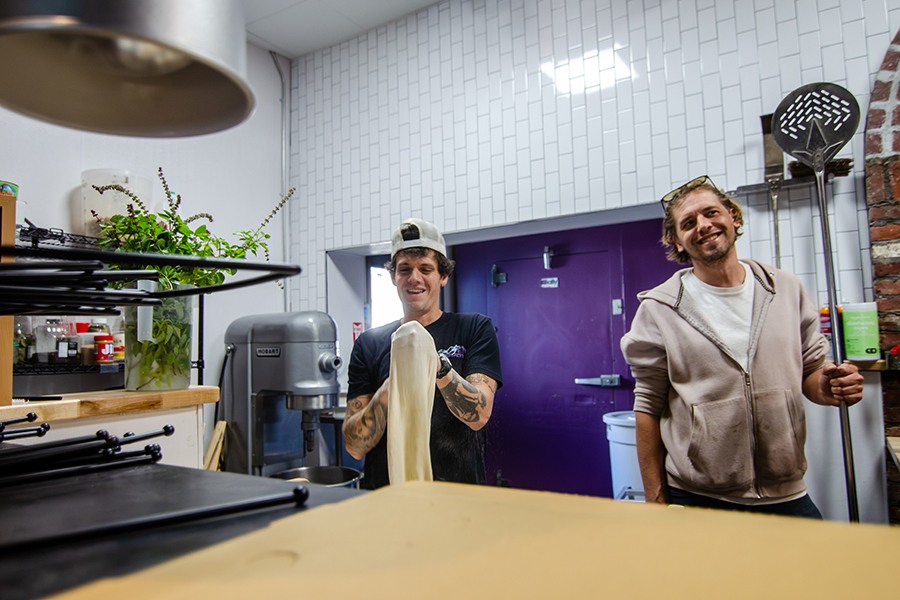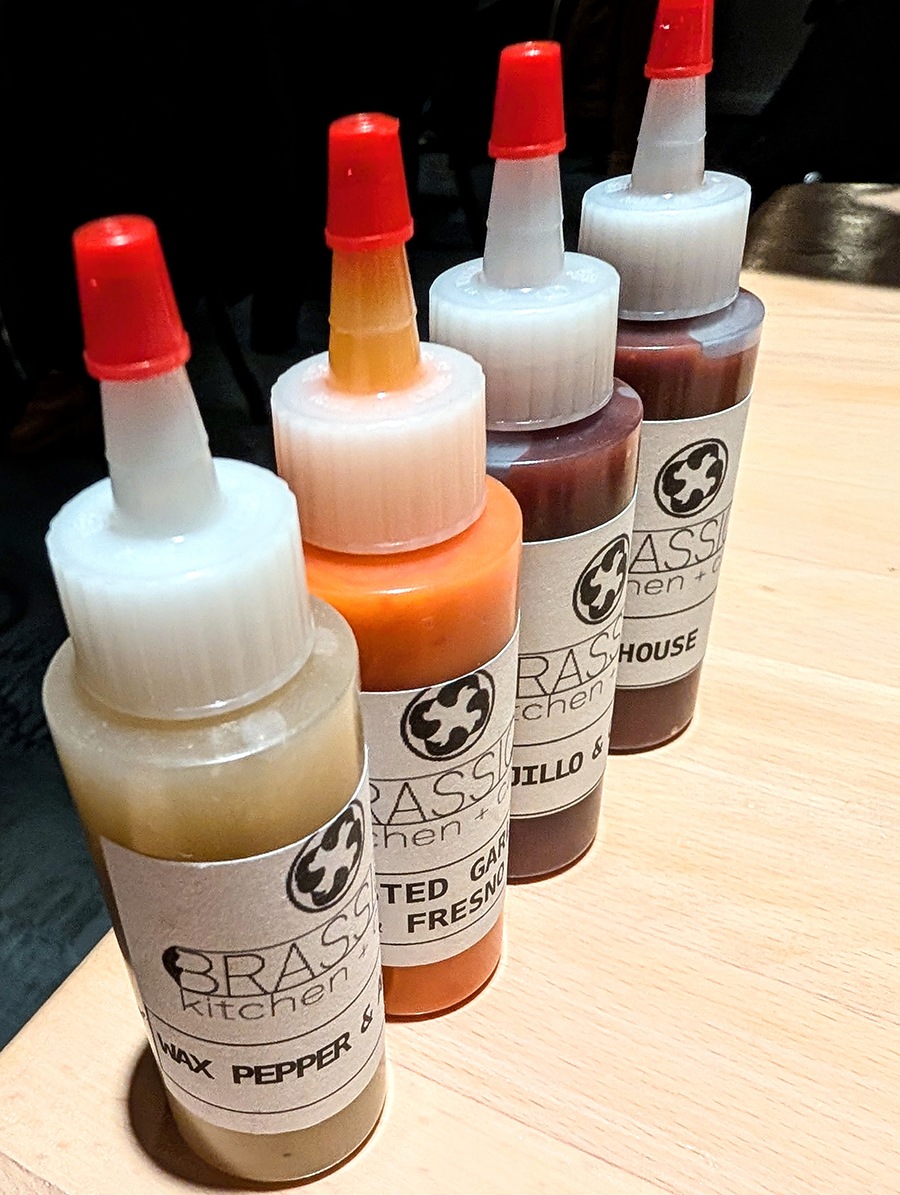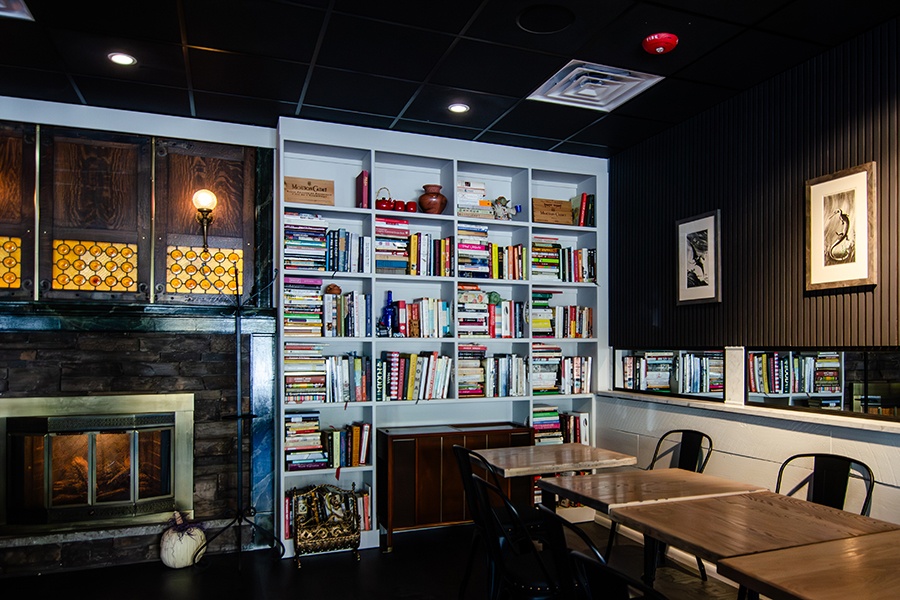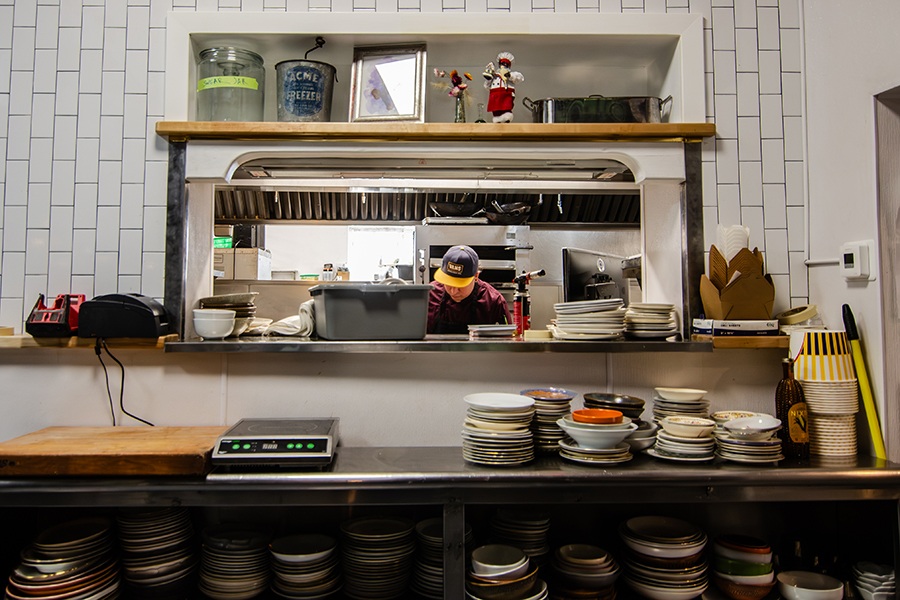News
A move to a big new space next door gives one of Boston’s funkiest, quirkiest restaurants the license to get even cooler—and to serve pizza.
Devoted foodies and restaurant newbies love The Feed. Sign-up now for our twice weekly newsletter.

The bar at the new Brassica. / Photo by Rachel Leah Blumenthal
The koji risotto at Jamaica Plain’s beloved Brassica Kitchen + Café needs itself to exist—each batch is made partly from the previous one, stretching back years in an unbroken chain, sort of like a sourdough starter. “You need to make it to continue it,” affirms co-chef and co-owner Jeremy (Jay) Kean. It’s a fitting signature dish for an eclectic restaurant that’s always fed off its history, upcycling techniques and ingredients to create cuisine beyond simple definition.

Co-owners and co-chefs Jeremy “Jay” Kean and Philip Kruta prepare pizza in the kitchen at the new Brassica. (Kean’s sister Rebecca, not pictured, is Brassica’s third owner, running front-of-house operations, “everything admin,” and more.) / Photo by Rachel Leah Blumenthal
Located across from the Forest Hills MBTA stop in the former Dogwood space, the idiosyncratic restaurant—known for its “good weird” mash-up of Italian-ish and Japanese-ish inspirations, French roots, and fermentation obsession—turned nine this year and recently moved from its cozy Washington Street nook into a bigger space next door. It was, and continues to be, equal parts neighborhood haunt (stumble in for hearty brunch or try the fried chicken, and you’ll understand why) and one of Greater Boston’s most special-occasion-worthy destinations. Now that it’s in a new purpose-built home rather than squeezed into an old café that never fully suited the team’s lofty ambitions, Brassica seems poised to achieve newer, funkier heights—while maintaining its unpretentious, welcoming roots. And hey, now there’s pizza, too.

Pizzas, sashimi, and wine at Brassica. / Photo by Rachel Leah Blumenthal
Brassica is, perhaps, one of the hardest Boston restaurants to define. When we compile our Top 50 Restaurants list each year, we slap a brief cuisine label on each venue—Thai, seafood, Japanese, etc.—but this one’s always a head-scratcher. (We went with “New American” this year. We tried.) The identity has been a question since the beginning, says Kean. “Where I’ve ended is ‘fermentation-forward French cuisine.’ We were trained French, although we’re focused on Italian and Japanese techniques—we have kind of an Italian izakaya vibe. Our style that we put into it is upcycling and fermentation, heading in the direction of zero-waste.”

The new Brassica. To the right, out of frame, is an additional dining room that can be used for private groups. / Photo by Rachel Leah Blumenthal
So maybe: Brassica is a zero-waste-aspirational, fermentation-forward Italian izakaya with a French core and a new obsession with perfecting pizza? Better yet: Brassica is a Jamaica Plain gem that’ll knock your socks off with recognizable dishes (fried chicken, doughnuts, Bolognese) and wacky creations (an absolutely irresistible pork belly and marshmallow dish). Warm service and creative cocktails seal the deal, not to mention little quirks like burnt-beyond-recognition pizzas being used as decor—how many can you spot? (“We’ve been keeping burnt food and making art out of it for a long time,” says Kean with a laugh. It started as a joke a decade ago when he left a pan of cauliflower in an oven overnight. It got completely charred when someone turned the oven back on the next day, and co-chef and co-owner Philip Kruta framed it as a Christmas present for Kean.)

Brassica’s pork belly with brown buttered marshmallow and ginger chutney. / Photo by Rachel Leah Blumenthal
Speaking of reused parts, let’s get back to that koji risotto, a longtime menu staple made with parmesan and parmesan shoyu. The comforting dish looks like a simple bowl of porridge but packs tons of umami flavor. “It’s probably the closest we’ve gotten to zero-waste,” says Kruta. Years ago, he and Kean started learning about koji—essentially a mold-inoculated grain that drives the fermentation of soy sauce, sake, and more—with expert Rich Shih, whose fermentation work is well-known around Boston restaurant circles.

Brassica’s koji risotto with parmesan and parmesan shoyu. / Photo by Rachel Leah Blumenthal
As Kean tells it, Kruta wondered what would happen if they tried growing koji on arborio rice, the traditional base for risotto. “Phil, that’s expensive rice,” Kean said at the time. But a love of experimentation won out: The duo grew koji on arborio rice and cooked it in parmesan broth. “We took a big parmesan wheel, cut the rinds off, made the broth—it turned out amazing,” says Kean. “We put it right on the menu. And then one of our cooks, who likes to think, said, ‘What if we take some of the rinds and try making a shoyu?’” That was great, but there were still a lot of rinds, so the team also started making miso with a combination of soybeans and the parmesan rinds. “So now when we make the broth, we’re using parmesan miso from the rinds of previous broths. The entire dish just moves in a circle. It needs itself.” It’s been on the menu for six or seven years now, and aside from some plastic packaging that ingredients arrive in, there’s “basically zero waste,” says Kean.

Brassica has four house fermented hot sauces on the menu at any given time, featuring a variety of peppers and other vegetables, fruits, and more. / Photo by Rachel Leah Blumenthal
The cyclical nature isn’t just a cute detail about a dish; it’s Brassica’s entire philosophy, with Kean and Kruta’s emphasis on waste reduction through fermentation and upcycling continuing throughout the menu. The fan-favorite, ultra-crispy fried chicken, for instance, is the perfect vehicle to try the fermented house hot sauces of the moment, such as caramelized pineapple or toasted garlic. (Pro tip: Order all four; they’re served in takeout-friendly two-ounce bottles so you can bring the rest home.) Blonde miso and maple umeboshi elevate the humble Brussels sprout; the fried rice mixes fresh and fermented vegetables for added oomph. Or take the Bolognese, which has been around in some form or another since Kean and Kruta’s pre-Brassica days running a pop-up called Whisk. “We’ve never made it the same twice,” says Kean, “but we’ve always used the same technique, originally inspired by Jody Adams, who’s totally my mentor. Lots of stock; lots of reduced vegetables, reduced carrot juice, wine, different misos.” A recent incarnation involved fermented tomato water and lots of duck, “which helps with the zero-waste,” says Kruta, as there was simultaneously a dry-aged duck breast entrée on the menu.

The flames from Brassica’s wood-fired oven can be seen from the Forest Hills MBTA stop across the street. / Photo by Rachel Leah Blumenthal
While most of the menu—ever-changing as it is, but with recognizable throughlines—is familiar, the pizza is a new endeavor, courtesy of the wood-fired brick oven that came with the space. “We’re still Brassica,” says Kean, “but we have made a commitment to getting, really, really, really good at pizza, and we’re at the very beginning of that process.” Unsurprisingly, the dough undergoes a long fermentation to result in its light, airy crust. “You should be able to eat this and not feel weighed down, like you just ate sushi or something [light].” Among the round pies with rotating toppings, there’s also a rectangular pan pizza called “Detroit,” a nod to Detroit-style pizzas. But besides the shape, it’s really more reminiscent of Roman-style pizza al taglio, says Kean—the team did start developing it like a Detroit-style pizza but ended up doing a Roman dough to lighten the crust. A wise choice: Diners are going to want to save room for plenty of non-pizza dishes, too. (The best way to go about trying a wide variety of dishes, including some off-menu surprises, is via the tasting menu, dubbed “The Ride”—a relative steal at $100/person, including tax and tip.)

Brassica’s second dining room, featuring a fireplace and a cookbook collection, can play host to private groups. / Photo by Rachel Leah Blumenthal
Brassica 2.0—complete with a spacious bar and a private dining room with a fireplace—feels all grown up, a little bit swankier and smoother around the edges, maybe more befitting a special-occasion, tasting-menu dinner. But it’s easy to miss, just a little bit, the offbeat charm of dining on this exceptional food in Brassica’s previous space, which had that cozy, lived-in feel representative of its for-the-neighborhood focus. “I love this [new] space, and I’m so happy to be in here,” says Kean. “And I’m grieving the loss of our tiny little falling-apart restaurant. I like beater cars, but I really like nice cars, too.”

The new Brassica. / Photo by Rachel Leah Blumenthal
Says Kruta, who largely built the new space himself, with lots of input from the staff (conveniently working next door throughout the process): “I feel like everyone got 10 times better at their jobs just because of how efficient it is to work in here.” Happily, the soul of the old Brassica comes through in various ways, from reclaimed building materials used in the new space to some of the funding coming directly from longtime diners via a GoFundMe campaign.

Brassica’s sashimi with “faux wasabi.” The new kitchen features a dedicated station for preparing sashimi. / Photo by Rachel Leah Blumenthal
As far as the old space goes, Kean and Kruta are still figuring out what to do with it, “but it’s gonna be something cool,” promises Kean, with Kruta adding that it will be “complementary to [the new restaurant] and something the neighborhood needs.” And the new Brassica? The restaurant’s future will be, like everything else here, enmeshed with its past self, with a focus on providing the team opportunities to grow. “For the first 10 years, it was about us [Kean and Kruta] exploring cuisines, finding our own voice, doing it our way,” says Kean. “Now we have this generation of people who have come up under us; this expansion is for them. It’s for them to take the reins of that creative responsibility, understand the history, and make it into products. We’re trying to act more as guides. Wherever they start to take the cuisine, I think that’s going to be the next 10 years.”

Part of the kitchen at the new Brassica—much larger than in the previous space. / Photo by Rachel Leah Blumenthal
Says Kruta: “Now we have everything we need, and we can really focus on the craft, which means that we can really teach the craft. It’s a learning environment for the next generation of cooks.”
Brassica serves dinner Wednesday through Saturday and brunch on weekends. 3712 Washington St., Jamaica Plain, Boston, 617-477-4519, brassicakitchen.com.


Dining and Cooking